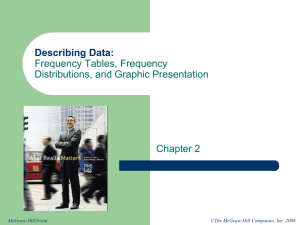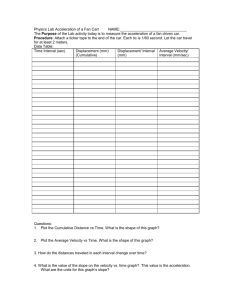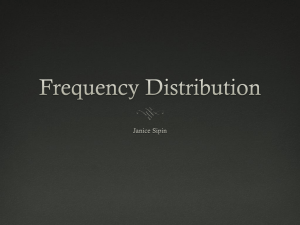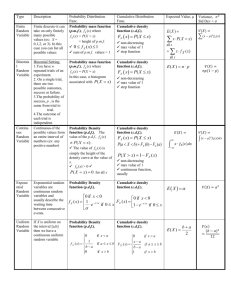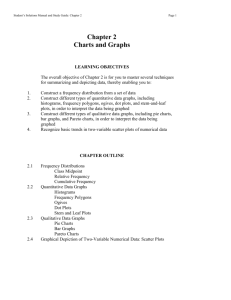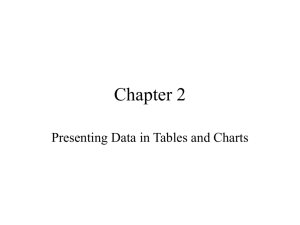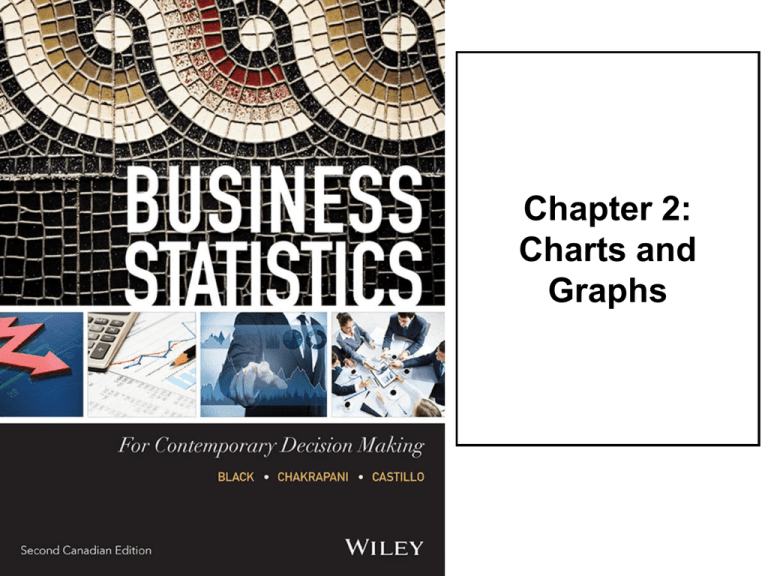
Chapter 2:
Charts and
Graphs
Learning Objectives
LO1
LO2
LO3
LO4
Explain the difference between grouped and ungrouped data and construct a frequency distribution
from a set of data and explain what the distribution
represents.
Describe and construct different types of quantitative
data graphs, including histograms, frequency polygons,
ogives, and stem and leaf plots. Explain when these
graphs should be used.
Describe and construct different types of qualitative
data graphs, including pie charts, bar charts, and Pareto
charts. Explain when these graphs should be used.
Display and analyze two variables simultaneously using
cross tabulation and scatter plots.
Ungrouped Versus Grouped Data
• Ungrouped data
– have not been summarized in any way
– are also called raw data
• Grouped data
– have been organized into a frequency distribution
Example of Ungrouped Data
Example of Grouped Data
Constructing a Frequency Distribution
Start With Data Range
Deciding on the Number of Classes and on
the Class Width
• The number of classes should be between 5 and 15.
– Fewer than 5 classes cause excessive summarization.
– More than 15 classes leave too much detail.
• Class Width
– Divide the range by the number of classes for an approximate class
width
– Round up to a convenient number
– So if the number of classes is 6, then
Class Midpoint
• The midpoint of each class interval is called the class midpoint
or the class mark.
Relative Frequency
The relative frequency is the proportion of the total frequency
that is any given class interval in a frequency distribution.
Cumulative Frequency
• The cumulative frequency is a running total of frequencies
through the classes of a frequency distribution.
Class Midpoints, Relative Frequencies, and
Cumulative Frequencies
Cumulative Relative Frequencies
• The cumulative relative frequency is a running total of the relative
frequencies through the classes of a frequency distribution.
Common Statistical Graphs
•
•
•
•
Histogram : vertical bar chart of frequencies
Frequency Polygon : line graph of frequencies
Ogive : line graph of cumulative frequencies
Pie Chart : proportional representation for
categories of a whole
• Stem and Leaf Plot
• Pareto Chart
• Scatter Plot
Histogram
20
20
18
15
Frequency
Class Interval Frequency
20-under 30
6
30-under 40
18
40-under 50
11
50-under 60
11
60-under 70
3
70-under 80
1
11
11
10
10
6
5
3
1
0
20
30
40
50
Years
60
70
80
Histogram Construction
20
20
18
15
Frequency
Class Interval Frequency
20-under 30
6
30-under 40
18
40-under 50
11
50-under 60
11
60-under 70
3
70-under 80
1
11
11
10
10
6
5
3
1
0
20
30
40
50
Years
60
70
80
Frequency Polygon
20
15
Frequency
Class Interval Frequency
20-under 30
6
30-under 40
18
40-under 50
11
50-under 60
11
60-under 70
3
70-under 80
1
10
5
0
10
20
30
40
50
Years
60
70
80
90
Ogive
50
40
Frequency
Class Interval
20-under 30
30-under 40
40-under 50
50-under 60
60-under 70
70-under 80
Cumulative
Frequency
6
24
35
46
49
50
30
20
10
0
20
30
40
50
Years
60
70
80
Cumulative Relative Frequency (Ogive)
1.0
Cumulative Relative Frequency
Class Interval
20-under 30
30-under 40
40-under 50
50-under 60
60-under 70
70-under 80
Cumulative
Relative
Frequency
.12
.48
.70
.92
.98
1.00
0.8
0.6
0.4
0.2
0.0
0
10
20
30
40
50
Years
60
70
80
90
Complaints by Train Passengers
Complaints by Train Passengers
Personnel
14%
Schedules,
Etc.
10%
Equipment
15%
Train
Performance
21%
Stations, Etc.
40%
Second Quarter Truck Production
(Hypothetical values)
Pie Chart Calculations for Company A
Second Quarter
Truck Production
17%
4%
1%
39%
39%
A
B
C
D
E
Visible Minority Population of Canada Census
2006
Ethnicity
Size of
population
Percentage
Equivalent in
Degrees
South Asian
1 262 865
24.92
89.71o
Chinese
1 216 595
24.00
86.40o
Black
783 795
15.47
55.69o
Filipino
419 700
8.10
29.16o
Latin American
304 245
6.00
21.60o
Arab
265 550
5.24
18.86o
South East Asia
239 935
4.73
17.03o
West Asians
156 695
3.09
11.12o
Korean
141 890
2.80
10.08o
81 300
1.60
5.76o
Other
204 540
4.04
14.54o
Total
5 068 095
100.00
360o
Japanese
Visible Minorities of Canada 2006
Safety Examination Scores
for Plant Trainees
Construction of Stem and Leaf Plot
Pareto Chart
Cross Tabulation
Cross tabulation is a process for producing a
two-dimensional table that displays the
frequency counts for two variables
simultaneously.
Scatter Plot
A scatter plot is a two-dimensional graph plot of pairs of
points from two numerical variables.
COPYRIGHT
Copyright © 2014 John Wiley & Sons Canada, Ltd. All
rights reserved. Reproduction or translation of this work
beyond that permitted by Access Copyright (The Canadian
Copyright Licensing Agency) is unlawful. Requests for
further information should be addressed to the
Permissions Department, John Wiley & Sons Canada, Ltd.
The purchaser may make back-up copies for his or her
own use only and not for distribution or resale. The
author and the publisher assume no responsibility for
errors, omissions, or damages caused by the use of these
programs or from the use of the information contained
herein.

